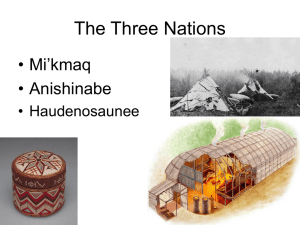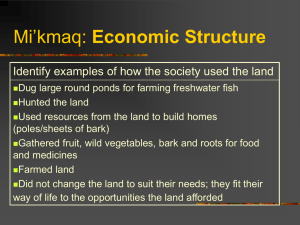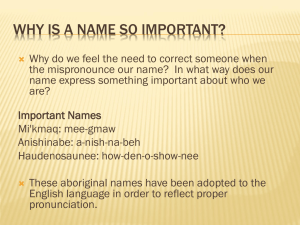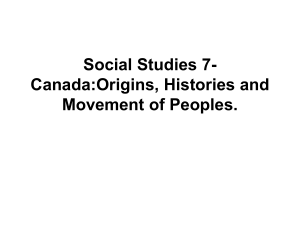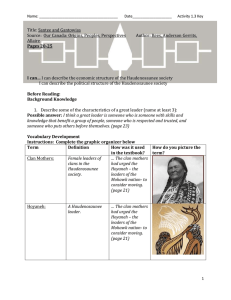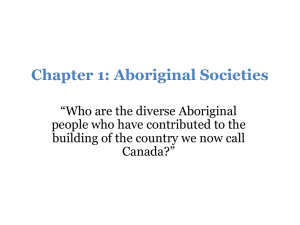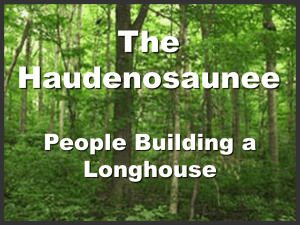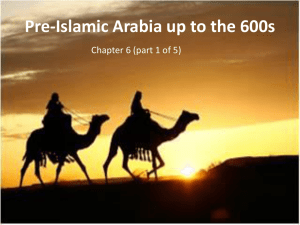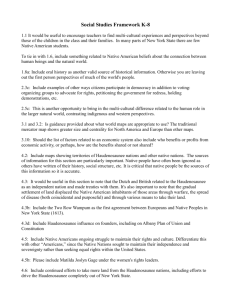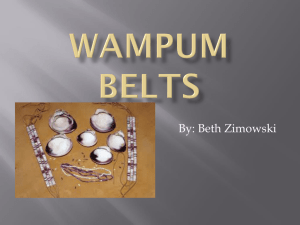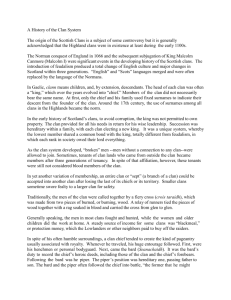Canadas First Nations
advertisement
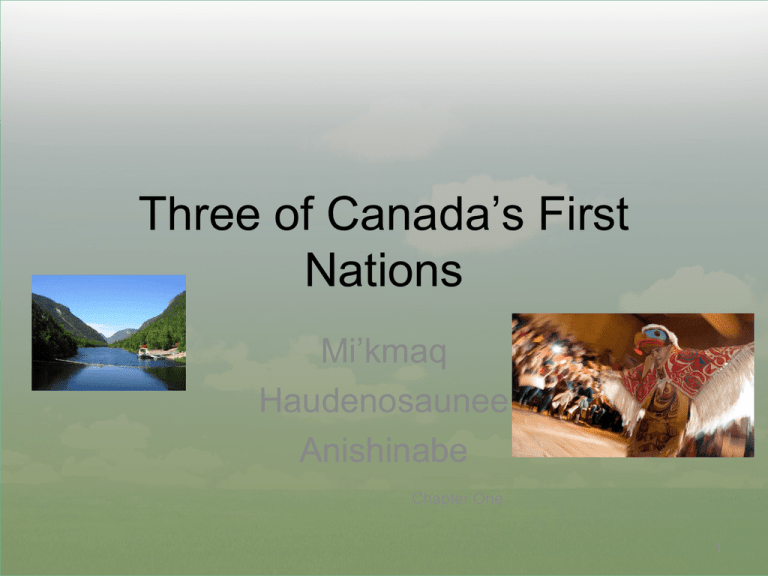
Three of Canada’s First Nations Mi’kmaq Haudenosaunee Anishinabe Chapter One 1 Questions to Look At: • What were the different ways in which Mi’kmaq, Haudenosaunee and Anishinabe societies structured? • How do environment and geography affect culture and identity? • How can connections to the past be important to identity? 2 Why these groups? These were some of the first groups to have contact with the European colonists; they were very affected by them! 3 Focus Area 4 Mi’kmaq Society A look into how their tribe is set up! 5 Seven Districts • Each district has local leaders (Saqamaws) who are chosen/advised by elders • There are district council meetings • Each district sends a rep to a Grand Council • The Grand Council meets once a year – Advises where to hunt, fish, set up camps – Manage relations with other First Nations 6 Seasonal Movement • Lived close to coast in summer, in the forest in the winter • Made best use of resources of the land • Fit their way of life to suit the land 7 How different do you think your life would be if you moved for the seasons? How do you think this has changed their worldview? 8 Mi’kmaq Society • Get respect in the tribe through accomplishments • Hunting is very important • Have respect for elders and for the different districts • Used foot, canoe, and toboggan to travel and transport goods • Lived in wigwams 9 Mi’kmaq Cont’d • Used all the resources around them (using evergreen branches to make mattresses) • Had mass amounts of respect for each district and would help each other out • Were religious – prayed and believe in the Creator • Men and women had different roles • All roles were viewed as important because it contributed to the whole • Sharing and support were extremely important 10 Questions • How did they make decisions? • What is the role of women? • How did geography/environment affect them? 11 http://www.youtube.com/watch?v=oynNPwFRQH8 12 Anishinabe A look into their society! 13 Dodems (clans) • Society made up of clans who each had different responsibilities • Clans worked together and provided balance • Joined the clan of your father • People in your clan were considered your brothers and sisters 14 Clans/Duties Clan Duty Explanation Crane, Loon Leadership Provide balanced government. Wouldn’t always agree, so all decisions were made carefully. Fish Teaching, scholarship Taught skills and values, would also help solve fights between the Cranes/Loons. Bear Policing Patrolled villages/camps and would identify useful plants for medicine. Hoof Community needs Made sure there was housing and recreation . Opposed violence, were often poets. Marten Defense Hunters, warriors, and military strategists. Bird Spiritual needs High level of spiritual development and well-being 15 16 Midewin Society • Men AND women who had special spiritual/healing gifts • People respected them • Had eight levels of secret training • Believed in having a good life, healed people, interpreted dreams/visions, and passed on sacred teachings/songs 17 Anishinabe Society • Believe in respect for all living things • Used different camps between Summer and Winter • Gather together to meet/make friends, exchange goods and food, do sports/ceremonies, and arrange marriages with different tribes • Men hunt, women would garden and cook • Ogimauh is the leader of the Anishnabe 18 Anishinabe Cont’d • Decisions were made by being voted on • Would make alliances by arranged marriages • Have councils which discuss and make decisions • Respect creation because thought that the Creator was present in everything • Do not accumulate wealth, they take what they need • Had special buildings for meetings; men and women were at them, sat in a circle 19 Questions • How did they make decisions? • What is the role of women? • How did geography/environment affect them? 20 Anishinabe Oral Tradition http://www.youtube.com/watch?v=r_9s6Shmtyg 21 The Haudenosaunee 22 The Great Law of Peace • Created a confederacy of six nations; the Cayuga, Mohawk, Oneida, Onondaga, Seneca, and Tuscarora • Spoke different languages/lived in different areas and had own clans/councils • Set rules of government, each member nation had an equal voice/status 23 Commitment to Peace • Represents the Great Law of Peace • The branches represent the nations • Roots represent peace and strength • The weapons is buried so there is no hostility among the nations 24 Grand Council • Made confederacy decisions • Were a council of 50 chiefs • Were called the Hoyaneh • Were chosen by the clan mothers • Made decisions like whether to go to war, enter into trade, sign treaties, etc. 25 Clan Mothers • Family tree is traced through mothers • Unites the nations as relatives • Were very powerful • Could also remove Hoyaneh from power if they were failing 26 Haudenosaunee Society • Lived in year round settlements in long houses • Several families would live together • Were an agricultural community • Would only move when the land would not produce food 27 Longhouse 28 Haudenosaunee Cont’d • The Peacemaker (brought the Great Law of Peace) was deeply respected (taught to respect all things) • Use dreams to help make decisions • Clan mothers bring decisions to the Hoyaneh who then make the final decision • Looked to the tribe to approve big decisions 29 Questions • How did they make decisions? • What is the role of women? • How did geography/environment affect them? 30 Haudenosaunee Society http://www.youtube.com/watch?v=i5mma0j17tQ 31
